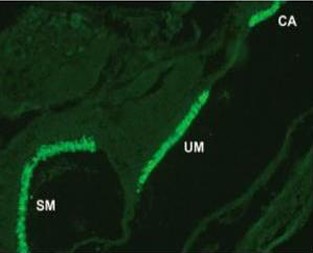| Weight | 1 lbs |
|---|---|
| Dimensions | 9 × 5 × 2 in |
| host | mouse |
| isotype | IgG1 |
| clonality | monoclonal |
| concentration | 1 mg/mL |
| applications | ICC/IF, WB |
| reactivity | Otoferlin |
| available sizes | 100 µg |
mouse anti-Otoferlin monoclonal antibody (13A9) 6467
$520.00
Antibody summary
- Mouse monoclonal to Otoferlin
- Suitable for: WB,IF,IHC
- Isotype: IgG1
- 100 µg
mouse anti-Otoferlin monoclonal antibody (13A9) 6467
| antibody |
|---|
| Tested applications WB,IHC,IHC,ICC/IF |
| Recommended dilutions Immunoblotting: use at 1-5ug/mL. A band of ~220kDa is detected. Immunofluorescence: use at 2-10ug/mL. These are recommended concentrations. Enduser should determine optimal concentrations for their applications. |
| Immunogen GST fusion protein corresponding to aa 1-395 of human otoferlin (accession no. Q9HC10). |
| Size and concentration 100µg and |
| Form lyophilized |
| Storage Instructions This product is stable for at least one (1) year at -20°C to -70°C. Reconstituted product should be stored in appropriate aliquots to avoid repeated freeze-thaw cycles. |
| Storage buffer Lyophilized, 0.1M Tris, 0.1M glycine, 2% sucrose |
| Purity protein affinity purification |
| Clonality monoclonal |
| Isotype IgG1 |
| Compatible secondaries goat anti-mouse IgG, H&L chain specific, peroxidase conjugated polyclonal antibody 5486 goat anti-mouse IgG, H&L chain specific, biotin conjugated, Conjugate polyclonal antibody 2685 goat anti-mouse IgG, H&L chain specific, FITC conjugated polyclonal antibody 7854 goat anti-mouse IgG, H&L chain specific, peroxidase conjugated polyclonal antibody, crossabsorbed 1706 goat anti-mouse IgG, H&L chain specific, biotin conjugated polyclonal antibody, crossabsorbed 1716 goat anti-mouse IgG, H&L chain specific, FITC conjugated polyclonal antibody, crossabsorbed 1721 |
| Isotype control Mouse monocolonal IgG1 - Isotype Control |
| target relevance |
|---|
| Protein names Otoferlin (Fer-1-like protein 2) |
| Gene names OTOF,OTOF FER1L2 |
| Protein family Ferlin family |
| Mass 226753Da |
| Function FUNCTION: Key calcium ion sensor involved in the Ca(2+)-triggered synaptic vesicle-plasma membrane fusion and in the control of neurotransmitter release at these output synapses. Interacts in a calcium-dependent manner to the presynaptic SNARE proteins at ribbon synapses of cochlear inner hair cells (IHCs) to trigger exocytosis of neurotransmitter. Also essential to synaptic exocytosis in immature outer hair cells (OHCs). May also play a role within the recycling of endosomes (By similarity). {ECO:0000250|UniProtKB:Q9ESF1}. |
| Subellular location SUBCELLULAR LOCATION: Cytoplasmic vesicle, secretory vesicle, synaptic vesicle membrane {ECO:0000250|UniProtKB:Q9ESF1}; Single-pass type II membrane protein {ECO:0000250|UniProtKB:Q9ESF1}. Basolateral cell membrane {ECO:0000250|UniProtKB:Q9ESF1}; Single-pass type II membrane protein {ECO:0000250|UniProtKB:Q9ESF1}. Endoplasmic reticulum membrane {ECO:0000250|UniProtKB:Q9ESF1}; Single-pass type II membrane protein {ECO:0000250|UniProtKB:Q9ESF1}. Golgi apparatus membrane {ECO:0000250|UniProtKB:Q9ESF1}; Single-pass type II membrane protein {ECO:0000250|UniProtKB:Q9ESF1}. Presynaptic cell membrane {ECO:0000250|UniProtKB:Q9ESF1}; Single-pass type II membrane protein {ECO:0000250|UniProtKB:Q9ESF1}. Cell membrane {ECO:0000250|UniProtKB:Q9ESF1}; Single-pass type II membrane protein {ECO:0000250|UniProtKB:Q9ESF1}. Note=Detected at basolateral cell membrane with synaptic vesicles surrounding the ribbon and at the presynaptic plasma membrane in the inner hair cells (IHCs) at postnatal day 30 (P30). Colocalizes with GPR25 and RAB8B in inner hair cells. {ECO:0000250|UniProtKB:Q9ESF1}. |
| Tissues TISSUE SPECIFICITY: Isoform 1 and isoform 3 are found in adult brain. Isoform 2 is expressed in the fetus and in adult brain, heart, placenta, skeletal muscle and kidney. |
| Structure SUBUNIT: Interacts with SNAP2; the interaction is direct. Interacts with STX1; the interaction is direct. Interacts with RAB8B (By similarity). {ECO:0000250}. |
| Domain DOMAIN: The N-terminal first 124 residues can be classified as C2 domain, based on their 3D-structure. They are not sufficient for calcium ion or phospholipid binding (By similarity). {ECO:0000250|UniProtKB:Q9ERC5}. |
| Involvement in disease DISEASE: Deafness, autosomal recessive, 9 (DFNB9) [MIM:601071]: A form of non-syndromic sensorineural hearing loss. Sensorineural deafness results from damage to the neural receptors of the inner ear, the nerve pathways to the brain, or the area of the brain that receives sound information. {ECO:0000269|PubMed:10192385, ECO:0000269|PubMed:12127154, ECO:0000269|PubMed:16097006, ECO:0000269|PubMed:16283880, ECO:0000269|PubMed:16371502, ECO:0000269|PubMed:26437881}. Note=The disease is caused by variants affecting the gene represented in this entry.; DISEASE: Auditory neuropathy, autosomal recessive, 1 (AUNB1) [MIM:601071]: A form of sensorineural hearing loss with absent or severely abnormal auditory brainstem response, in the presence of normal cochlear outer hair cell function and normal otoacoustic emissions. Auditory neuropathies result from a lesion in the area including the inner hair cells, connections between the inner hair cells and the cochlear branch of the auditory nerve, the auditory nerve itself and auditory pathways of the brainstem. In some cases AUNB1 phenotype can be temperature sensitive. {ECO:0000269|PubMed:16371502, ECO:0000269|PubMed:18381613}. Note=The disease is caused by variants affecting the gene represented in this entry. |
| Target Relevance information above includes information from UniProt accession: Q9HC10 |
| The UniProt Consortium |
Publications
| pmid | title | authors | citation |
|---|---|---|---|
| We haven't added any publications to our database yet. | |||
Protocols
| relevant to this product |
|---|
| Western blot IHC ICC |
Documents
| # | SDS | Certificate | |
|---|---|---|---|
| Please enter your product and batch number here to retrieve product datasheet, SDS, and QC information. | |||
Only logged in customers who have purchased this product may leave a review.









Reviews
There are no reviews yet.